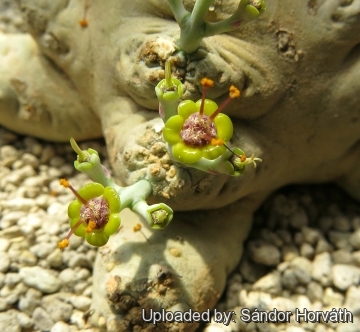
Euphorbia horwoodii Photo by: Sándor Horváth
The large plants with long branches often found in cultivation, especially the grafted ones, are not characteristic at all, in the wild the plants are very compact and specimens with branches more than 5 cm long are found only in the shelter of other vegetation.
Origin and Habitat: Bari Region, NE Somalia (SW of Iskushuban), not known elsewhere.
Altitude: 600–700 m over sea level.
Habitat: They was found growing on calcareous silt over limestone on open exposed areas among scattered grasses or under the shelter of shrubs, but now Euphorbia horwoodiiSN|18588]]SN|18588]] (likewise to other Somalian succulent like Whitesloania crassa) are probably extinct except for cultured stock obtained by collectors.
Synonyms:
See all synonyms of Euphorbia horwoodii
Description: Euphorbia horwoodiiSN|18588]]SN|18588]] is really a nice looking dwarf fibrous rooted succulent that in the juvenile stage forms a sphere with completely reduced branches and form compact side-arms later as it gets old. Mature plants about 5 cm high and 12 cm in diameter. But rarely cultivated plants on a graft retain their incredibly compact, highly evolved habit and often become almost a thorn bush with long messy side branches up to 30 (or more) cm in diameter. There seems to be several quite different looking clones known in cultivation.
Derivation of specific name: This species was named after the English horticulturist and succulent plant propagator, later emigrating to California Francis ("Frank") K. Horwood (1924–1987).
Root: Fibrous.
Stem: Younger seedlings develop a depressed globose body 3–5 cm in diameter, bearing usually spineless small spine-shields in 5 to 7 vertical rows, the branches are insipient (extremely short and completely retained within the spherical body) an not clearly discernible. Older mature specimens c. 5 cm high and 12 cm in diameter (eventually to 8 cm high and 30 cm in diameter) producing tightly packed branches in 5 to7 vertical series. Branches straight, rarely rebranching, 10-15 mm thick, up to 5 cm long (but up to 15 cm long in cultivation), occasionally very shortly rebranching; tubercles very shallow flattened c. 1 cm apart in 4–5 longitudinal series, pale greyish- green or greysh-brown with darker markings between the tubercles.
Spine-shields: Rounded to broadly obovate, about 2-5 mm long, 1-4 mm wide, quite distanced, but evident on seedling plants (absent on mature specimen).
Stipular spines: Asbsent or produced only when the branches begin to elongate from the globose body about 3-10 mm long.
Spines: Vestigial prickles absent, or vestigial and evident only on young growth.
Inflorescences: Solitary 1-forked cymes, from the flowering eyes present immediately above the spine-shields; peduncle and cyme-branches 2-3 mm long.
Flowers (cyathia): Male and female cyathia yellowish on the same plant at the tip of the arms, 3,5 mm in diameter. Nectar glands c. 1.5 mm broad, spreading, scarcely touching, yellow. Styles 2 mm long.
Fruit (capules): Capsule 2,5 mm long and 3 mm in diameter, vaguely 3-lobed exserted on a recurved pedicel 2.5 mm long.
Seeds: Ovoid 2 mm long and 1,4 mm in diameter, finely tuberculate.
Subspecies, varieties, forms and cultivars of plants belonging to the Euphorbia horwoodii group
Bibliography: Major references and further lectures
1) Urs Eggli “Illustrated Handbook of Succulent Plants: Dicotyledons” Springer Science & Business Media, 2002
2) Tom Jenkins “Tom Jenkins introduces Euphorbia horwoodii, a challenging Somalian species. In: British Cactus & Succulent Journal, Cactus & Succulent Society, 1997
3) “The Euphorbia Journal” Strawberry Press, 1994
4) Mesfin Tadesse “Flora of Ethiopia and Eritrea,” Volume 2, National Herbarium, Biology Department, Science Faculty, Addis Ababa University, 1995
5) “Flora Somalia”, Vol 1, (1993) Author S. Carter (Euphorbia, Monadenium), M. G. Gilbert (Acalypha, Andrachne, Antidesma, Bridelia, Caperonia, Cephalocroton, Chrozophora, Clutia, Dalechampia, Flueggea, Givotia, Manihot, Meineckia, Micrococca, Oldfieldia, Phyllanthus, Ricinus, Suregada, Tragia), and M. Thulin (Croton, Drypetes, Erythrococca, Excoecaria, Jatropha, Spirostachys and Thecacoris) [updated by M. Thulin 2008]
 Euphorbia horwoodii Photo by: Sándor Horváth
Euphorbia horwoodii Photo by: Sándor HorváthSend a photo of this plant.The gallery now contains thousands of pictures, however it is possible to do even more. We are, of course, seeking photos of species not yet shown in the gallery but not only that, we are also looking for better pictures than those already present.
Read More... Cultivation and Propagation: This specie has the fame to be quite tricky to cultivate. A very very light and warm place is highly appreciated, but full sun all day long stops the growth, which is not resumed very easily and will lead to the loss of the plant. It does best in a mineral soil, good drainage is essential. Water sparingly during the summer months and keep dry in winter. In the short growing season it likes ample water and in this period it grows rather quickly, though not for a long time. When not in growth, Euphorbia schizacanthaSN|22921]]SN|22921]] is killed right away, when given too much water. It is a slow growing long lived plant and once established, it will be content in its position and with its soil for years. It can tolerate moderate shade, and a plant that has been growing in shade should be slowly hardened off before placing it in full sun as the plant will be severely scorched if moved too suddenly from shade into sun.
Propagation: It is propagated from seed sown during spring or summer. Germination occurs within 3 weeks a small globular plant emerges and keeps the shell on top for 2 or 3 months, but removing the shell right away is a recipe for failure. Usually when these plants finally shed the seed shell, the first cotyledons appear, with growth starting between them as is normal in plants. Sowing seed is the surest method of growing typical offspring and seedlings are in the first season relatively easy to grow.
It can be reproduced by cuttings or grafting as well but often lateral branches fail to produce the characteristic thick main stem.












